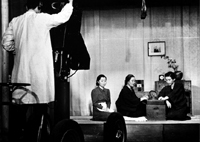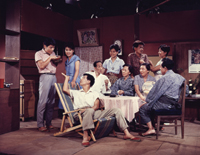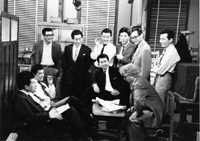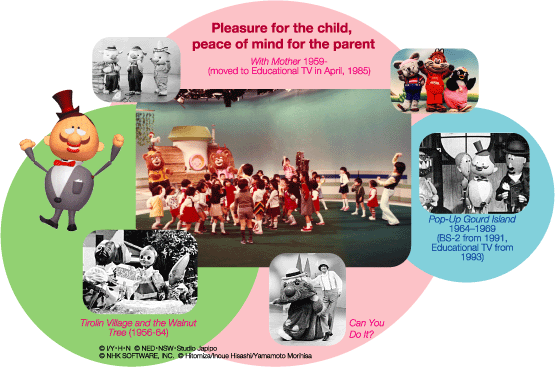
| The years between 1955 and 1964 were marked by fierce competition among the mass media. In 1958, the cumulative total of movie-goers reached 1.1 billion, while the number of households paying radio reception fees peaked in 1959. Over the next five years, however, the movie-going population was reduced by half as TV became the main provider of household entertainment. |
Drama and children's programs |
| Start of TV drama
Even before the war, NHK was making TV dramas. One example, transmitted on an experimental basis in 1940, was a one-act production entitled Before Supper. Written by Ima Harube, it portrayed a family gathering at home.
During the period of test broadcasting in the postwar years, other one-act TV dramas included Album of a Newly-wed Couple (1952) written by Yamamoto Kajiro. Production took place in a small studio under harsh lighting. The time was ripe for breakthroughs in both technology and directing. To help prepare for the start of full-scale TV broadcasting, NHK obtained valuable technical input by inviting veteran directors from NBC, one of the leading American networks, and sending NHK producers to the United States. First drama series In November of 1953, the year full-scale TV broadcasting commenced, NHK's first TV drama serial began. It was a weekly series called Ups and Downs to Happiness written by Kon Hidemi, which ran for three months. This was followed by Lamp at the Settlement (by Hasegawa Shin) in 1954; Pursuit (by Uchimura Naoya) in 1955, which won the first Grand Prize in that year's National Arts Festival; and At the Last Moment (by Kikushima Ryuzo) in 1956, which won the same prize in that year. Since video recording had yet to be introduced, even lengthy dramas had to be aired live, putting both the actors and director under considerable strain. Even so, Pursuit featured four locations in the same live broadcast: studios in Tokyo and Osaka, Tsukishima Pier in Tokyo and Dotonbori in Osaka. |
Movie industry opposition
Meanwhile, a crisis was approaching in the form of a confrontation with Japan's movie industry, which regarded TV as a dangerous rival. The year 1956 marked a watershed in the struggle. Five major Japanese film companies—Toho, Shochiku, Daiei, Toei, and Shin Toho—concluded an agreement not to sell any movies to TV, nor to allow actors and actresses under exclusive contract to them to appear on TV. (In 1958, a sixth film company, Nikkatsu, signed the same agreement.) As a result, all ties between the TV and movie industries were severed. Faced with few options, TV turned to American content instead. In 1956, NHK aired Whistling Man and Highway Patrol, and in 1957, I Love Lucy. This brought to Japanese TV screens a flood of images reflecting the affluence of American culture and lifestyles. Specifically Japanese dramas NHK continued to produce popular TV drama series such as Backstreet Alley, written by Tsutsui Keisuke and Sudo Izuho, and News Reporter, written by Shimada Kazuo, both of which were launched in 1958. These series exemplified a new type of drama specifically suited to the pace and rhythm of life in Japan.
|
|||||||
|
|




